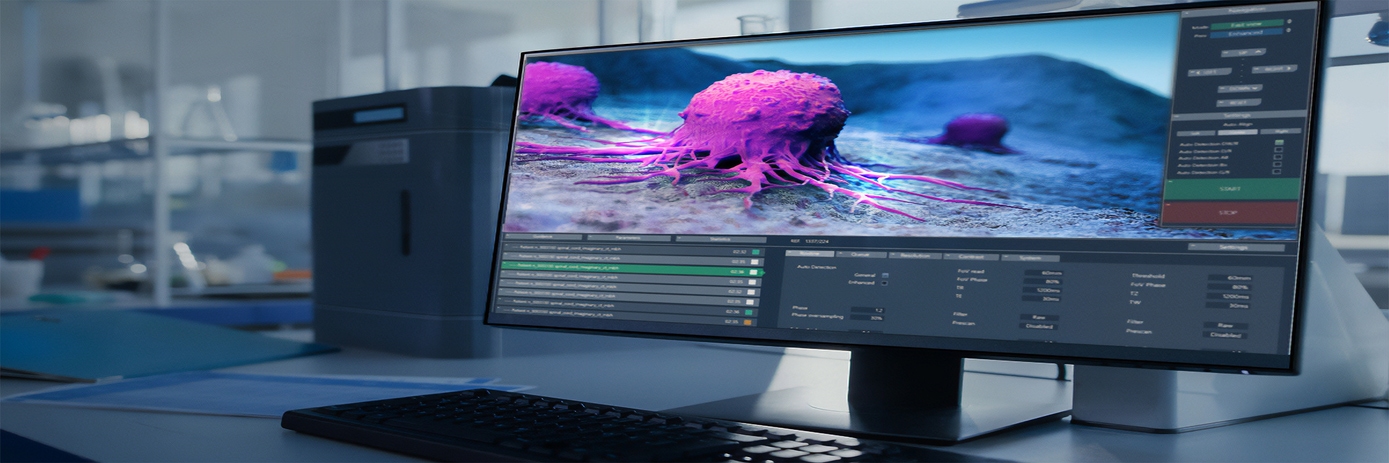In recent years, the way that we describe—and subsequently understand—cancer development and progression has shifted significantly. We’ve transitioned from the insular view that cancer is solely a mass of highly proliferating mutated cells toward acknowledging that cancer comprises an evolving heterogeneous ecosystem of mutated cells nestled within an equally complex host microenvironment.
This tumor microenvironment (TME) comprises a wide variety of cell types including immune cells, stromal cells, blood vessels, and extracellular matrix (ECM). Tumor cells are continuously exchanging information with the TME in order to support their growth, progression, and metastasis. This cellular crosstalk can also alter the susceptibility of tumor cells to anti-cancer therapeutics, potentially inducing treatment resistance.
To fully understand tumor progression, metastasis, and drug resistance, scientists need to reconstitute the tumor and its physiological environment. Traditionally, this has been achieved through the use of 2D monolayer cultures; however, such models do not fully recapitulate the 3D structure of the original tumors or retain the mutational profiles of their parental tumors.
More recently the use of 3D cellular models has surged in popularity; due in part to advances in instrumentation and reagents which enable the growth and analysis of such models at scale. For instance, patient-derived tumoroids (PDTs), which are 3D cultures of tumor cells derived from individual subjects, provide a more physiologically relevant platform to investigate cancer growth and progression, as well as understand subject-specific response to treatment, than 2D cell cultures.
Vascularized 3D tumoroid models
As the field of 3D cell cultures evolves, scientists are increasingly looking to fine tune these models by including microenvironmental factors to better reflect the pathology of in vivo tumors. For example, a group of researchers recently established a vascularized PDT model of non-small cell lung cancer (NSCLC) which mimics the vascular network of the in vivo tumor and its microenvironment.1
Discussing the importance of their work in the journal Biomedicines, Joseph Seitlinger and colleagues said: “Besides the pharmacokinetics and the pharmacodynamics of the drug, the transport of therapeutical molecules to solid tumors depends not only on the microvessel network established inside the tumor, but also on the properties of the extravascular tissue component. Thus, to develop a functional microvascular network surrounding and within the tumor is fundamental for an efficient treatment.”
For the study, the team first added human lung fibroblast cells to tumor cells to form complex PDTs. The PDTs were then vascularized with primary human endothelial cells and after three days of separate culture, combined with a pre-vascularized matrix to mimic the real in vivo environment. Commenting on their findings, Seitlinger et al. said: “We have successfully shown that the vessels neovascularized in the matrix could indeed be connected with those neovascularized in the PDTs.”
The team concluded that this model could be used in the future to test develop conventional iimproved therapies such as radiotherapy, chemotherapy, immunotherapy, or virotherapy for personalized medicine, or could be further implemented in a microfluidic device to perform drug screening discovery for personalized medicine.
Maintaining an intact tumor immune microenvironment in PDTs
Another team of researchers used a combination of high-content image analysis, flow cytometry, and cytokine analysis to compare the tumor immune microenvironment in PDTs with matched 2D dissociated cells from the same subjects.2
Multiplex cytokine release assays revealed that removal of the ECM by digestive enzymes significantly affected the tumor immune microenvironment. When the tumor models were treated with two immuno-oncology drugs, pembrolizumab (Keytruda®) and atezolizumab (Tecentriq®), flow cytometry analysis demonstrated differential T-cell and NK cell activation between the unpropagated 3D-tumoroid and dissociated cell suspension models. Finally, high-content imaging studies combined with flow death analysis indicated that the tumor ECM may plays an important role in tumor cell killing by immuno-oncology drugs.
“Our data shows the importance of maintaining the stoichiometry and cell-to-cell interactions of the tumor microenvironment,” concluded the researchers. “These data [also] demonstrate that intact tumor ECM within unpropagated 3D tumoroids is critical for a more accurate assessment of therapy-mediated changes in tumor immune microenvironment.”
For research use only. Not for use in diagnostic procedures.
References
- Seitlinger, J., Nounsi, A., Idoux-Gillet, Y., Santos Pujol, E., Lê, H., Grandgirard, E., Olland, A., Lindner, V., Zaupa, C., Balloul, J., Quemeneur, E., Massard, G., Falcoz, P., Hua, G. and Benkirane-Jessel, N., 2022. Vascularization of Patient-Derived Tumoroid from Non-Small-Cell Lung Cancer and Its Microenvironment. Biomedicines, 10(5), p.1103.
- Agrawal, V., Mediavilla-Varela, M., Page, M., Kreahling, J. and Altiok, S., 2019. Abstract 42: The importance of intact tumor immune microenvironment in unpropagated 3D fresh patient tumoroids in immuno-oncology drug testing for immunogenic tumor cell death and T-cell activation. Cancer Research, 79(13_Supplement), pp.42-42.

































